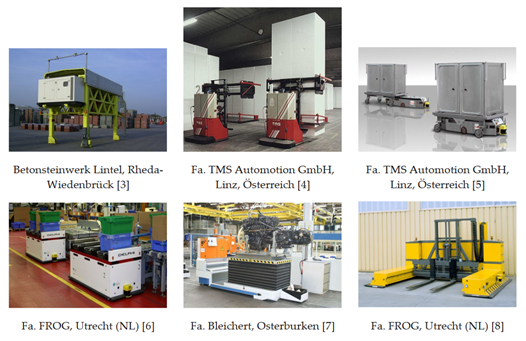+49 89 44 388 99 50
contact@smart-applications.com
Also use our contact form.
An Automated Guided Vehicle (AGV) or German driverless transport vehicle is a floor-bound and automatically moving conveyor. Several AGVs can be connected with the associated infrastructure as a driverless transport system (DTS). DTS consist of driverless transport vehicles, a control station, an instrument for determining the location, and recording the situation, an instrument for data transmission, and peripheral devices such as e.g. charging stations. The master control takes on the task management by assigning an order to each AGV, whereby approaches for self-organized AGVs are becoming increasingly important.

AGVs have been known in Europe since the 1960s and are now used in almost all industrial sectors to transport materials and goods autonomously. Goods of various dimensions, sizes, and shapes can be transported over a defined network of routes. For this purpose, passive load handling devices, such as storage areas or mounting devices, or active load handling devices, such as roller conveyors, chain and belt conveyors for picking up load carriers are installed on the AGVs. By permanently scanning the driving area, AGVs can be used in automated work areas, but also in areas with pedestrian traffic. In addition to the possibility of exchanging the load handling devices on the AGVs, the vehicles themselves also differ depending on the area of application. Within the area of small warehouses, only a few kilograms of goods can be transported, while the large AGVs transport loads of up to 50 tons. Also, they now distribute sterile food in hospitals, transport overseas containers in the port of Hamburg, pull tugger trains in assembly plants, or serve as mobile picking robots. Thus, AGVs can be used extremely flexibly and the fields of use are constantly expanding.

AGVs, compared with manual transport (e.g. forklifts), are used more and more frequently because they have several advantages:
The trend in industry and logistics is increasingly towards digitization or intelligent factories with industry-standard 4.0 and flexibly adaptable systems. In doing so, processes regarding automation are increasingly questioned. In the meantime, AGVs with artificial intelligence are already being used, which exchange information with one another, learn from one another, and control themselves autonomously through the material flow. This creates adaptive systems with a high level of robustness against disruptions and unforeseen changes in the process flow. Above all, the networking of the AGVs with one another and with the entire production process has the potential to significantly improve the profitability of a company.
Soon you will find here suitable apps for the topic: AGV - Augmented Guided Vehicles